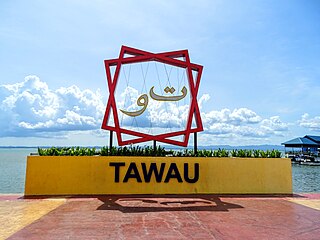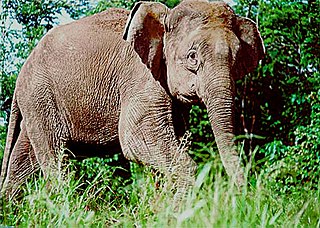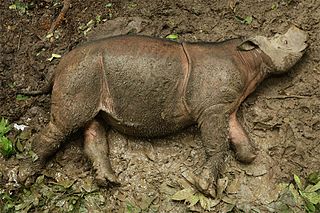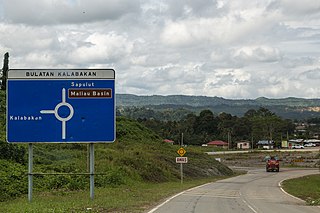Related Research Articles

The bay cat, also known as the Bornean bay cat, is a small wild cat endemic to the island of Borneo that appears to be relatively rare compared to sympatric wild cats, based on the paucity of historical, as well as recent records. Since 2002, it has been listed as Endangered on the IUCN Red List because it is estimated that fewer than 2,500 mature individuals exist, and that the population declined in the past. The bay cat has been recorded as rare and seems to occur at relatively low density, even in pristine habitat.

The otter civet is a semiaquatic viverrid native to Thailand, Malaysia, Indonesia and Brunei. It is listed as Endangered because of a serious ongoing population decline, estimated to be more than 50% over the past three generations, inferred from direct habitat destruction, and indirect inferred declines due to pollutants.

Lahad Datu is the capital of the Lahad Datu District in the Dent Peninsula on Tawau Division of Sabah, Malaysia. Its population was estimated to be around 27,887 in 2010. The town is surrounded by stretches of cocoa and palm oil plantations. It is also an important timber exporting port. The town has an airport for domestic flights.

Tawau, formerly known as Tawao, is the capital of the Tawau District in Sabah, Malaysia. It is the third-largest city in Sabah, after Kota Kinabalu and Sandakan. It is located on the Semporna Peninsula in the southeast coast of the state in the administrative centre of Tawau Division, which is bordered by the Sulu Sea to the east, the Celebes Sea to the south at Cowie Bay and shares a border with North Kalimantan, Indonesia. The town had an estimated population as of 2010, of 113,809, while the whole municipality area had a population of 397,673. The municipal area had a population of 372,615 at the 2020 Census.

The Kinabatangan River is a river in Sandakan Division, in northeastern Sabah, Malaysia. It is the second longest river in Malaysia, with a length of 560 km (350 mi) from its headwaters in the mountains of southwest Sabah to its outlet at the Sulu Sea, east of Sandakan. The area is known for its high biodiversity, including its limestone caves at Gomantong Hill, dryland dipterocarp forests, riverine forest, freshwater swamp forest, oxbow lakes, and salty mangrove swamps near the coast.

Tawau Hills Park, was established in 1979, primarily as a protection for the water catchment area of Tawau town, Sabah, Malaysia. It is located 24 kilometres from Tawau, and comprises 279.72 km² of lowland dipterocarp rainforest, surrounded by oil palm and cacao plantations. The park offers picnic areas, camping sites, and chalets. The Park contains rugged volcanic landscapes including a hot spring and spectacular waterfalls. The highest point in the park is Gunung Magdalena. It is administered by the Sabah Parks.

Danum Valley Conservation Area is a 438 square kilometres tract of relatively undisturbed lowland dipterocarp forest in Sabah, Malaysia. It has an extensive diversity of tropical flora and fauna, including such species as the rare Bornean orangutans, gibbons, mousedeer, clouded leopards and over 270 bird species. Activities offered are jungle treks, river swimming, bird watching, night jungle tours and excursions to nearby logging sites and timber mills.

The Borneo elephant, also called the Bornean elephant or the Borneo pygmy elephant, is a subspecies of Asian elephant (Elephas maximus) that inhabits northeastern Borneo, in Indonesia and Malaysia. Its origin remains the subject of debate. A definitive subspecific classification as Elephas maximus borneensis awaits a detailed range-wide morphometric and genetic study. Since 1986, the Asian elephant has been listed as Endangered on the IUCN Red List as the population has declined by at least 50% over the last three generations, estimated to be 60–75 years. It is pre-eminently threatened by loss, degradation and fragmentation of habitat.

The Borneo lowland rain forests is an ecoregion, within the tropical and subtropical moist broadleaf forests biome, of the large island of Borneo in Southeast Asia. It supports approximately 15,000 plant species, 380 bird species and several mammal species. The Borneo lowland rain forests is diminishing due to logging, hunting and conversion to commercial land use.

Malaysia faces several environmental issues. Malaysia's environment possesses megadiverse biological diversity, with globally significant endemism and biodiversity, but is threatened by several issues. Deforestation is a major issue in the country that has led to many species becoming threatened with extinction. As a major economic sector, palm oil production has had a substantial environmental impact. Air pollution is also a major issue, with the country one of the most affected countries by seasonal Southeast Asian haze. The country is also affected by climate change.

The environment of Malaysia is the biotas and geologies that constitute the natural environment of Malaysia. Malaysia's ecology is megadiverse, with a biodiverse range of flora and fauna found in various ecoregions throughout the country. Tropical rainforests encompass between 59% to 70% of Malaysia's total land area, of which 11.6% is pristine. Malaysia has the world's fifth largest mangrove area, which totals over a half a million hectares.
Palm oil, produced from the oil palm, is a basic source of income for many farmers in South East Asia, Central and West Africa, and Central America. It is locally used as cooking oil, exported for use in much commercial food and personal care products and is converted into biofuel. It produces up to 10 times more oil per unit area than soybeans, rapeseed or sunflowers.

Deforestation in Borneo has taken place on an industrial scale since the 1960s. Borneo, the third largest island in the world, divided between Indonesia, Malaysia and Brunei, was once covered by dense tropical and subtropical rainforests.

The Borneo montane rain forests is an ecoregion on the island of Borneo in Southeast Asia. It includes montane tropical and subtropical moist broadleaf forests, also known as a cloud forests. The ecoregion is partly in East Malaysia and Indonesia (Kalimantan).

The Sabah Foundation (Malay: Yayasan Sabah) or Yayasan Sabah Group (YSG) is a state sanctioned organisation that was developed to promote educational and economic opportunities for its people. It was founded by Tun Mustapha Harun and manages a diverse portfolio of resources and issues.

The Bornean rhinoceros, also known as the eastern Sumatran rhinoceros or eastern hairy rhinoceros, is one of three subspecies of Sumatran rhinoceros. The subspecies may be functionally extinct, with only one individual, a female named Pahu, surviving in captivity, and held in the state of Sabah. In April 2015, the Malaysian government declared the Bornean rhinoceros to be extinct in the wild in the Malaysian portion of Borneo. However, in March 2016, a young female rhino was captured in East Kalimantan, providing evidence of their continued existence. The International Union for Conservation of Nature (IUCN) classifies the subspecies as critically endangered.
Tawai Forest Reserve is a protected forest reserve in Telupid District of Sandakan Division, Sabah, Malaysia. It was first created in January 1972, before being designated as a Class 1 Protection Forest by the Sabah Forestry Department in 1984. It was fully demarcated in 2002, resulting in an area of 22,697 hectares (226.97 km2). The reserve is mostly mountainous, consisting of ultramafic forest, upland mixed dipterocarp forest and kerangas forest. Mount Tawai, at 1,273 metres (4,177 ft), is within the reserve. It is flattest near its northern and eastern edges. The Tawai waterfall is located within the reserve, part of the many rivers which flow through it. Protection of these headwaters was part of the reason for the reserve's establishment. The reserve has been badly affected by fires that have spread into the reserve from nearby settlements and palm oil plantations. Illegal logging has occurred in areas of dipterocarp forest. Illegal logging and land clearance has occurred in some portions of the reserve. There are plans for the Pan-Borneo Highway to be expanded in part through the northern portion of the reserve. The forestry department runs a Rainforest Camp to generate tourism money, providing access to the clean river water of the reserve, rainforest treks, and a waystop near the path of the Sandakan Death Marches.

Kalabakan is a district in the Malaysian state of Sabah, located approximately 235 kilometres (146 mi) southeast of the state capital of Kota Kinabalu. It recorded a population of 48,195 people in the 2020 Malaysian census. Its capital is the town of Kalabakan.
Mount Pock Forest Reserve is a protected forest reserve in Semporna District of Tawau Division, Sabah, Malaysia. It was designated as a Class 1 Protection Forest by the Sabah Forestry Department in 1984. Its area is 7,804.8 hectares (78.048 km2). The reserve consists of steeply sloping terrain. The forest on lower slopes has been impacted by logging and conversion of land for agriculture. Oil palm plantations surround the reserve. The size of the reserve has decreased since its initial gazetting. In 2012, 1,388 ha (13.88 km2) of the Mount Pock Reserve was reclassified as state land as this area, along with parts of other reserves, have been home to indigenous communities.
References
- ↑ http://borneoscience.ums.edu.my/wp-content/uploads/2011/08/A-Survey-Of-The-Mammalian-Fauna-Of-The-Gunung-Rara-Forest-Reserve-Tawau-Sabah.pdf [ bare URL PDF ]
- ↑ "Sabah Authorities Considers Reward for Information on Dead Elephants – Lipstiq.com".
- ↑ "Poison suspected in pygmy elephant deaths".
- ↑ "Conservation news - Environmental science and conservation news".
- ↑ "'No more jumbo carcasses' - General - New Straits Times". Archived from the original on 2013-02-02.
- ↑ "14th endangered Borneo elephant found dead in forest reserve - CBS News". CBS News . Archived from the original on 2013-01-31.
- ↑ "Op-Ed: Malaysia sacrifices its rare pygmy elephants for palm oil". Archived from the original on 2013-02-09.